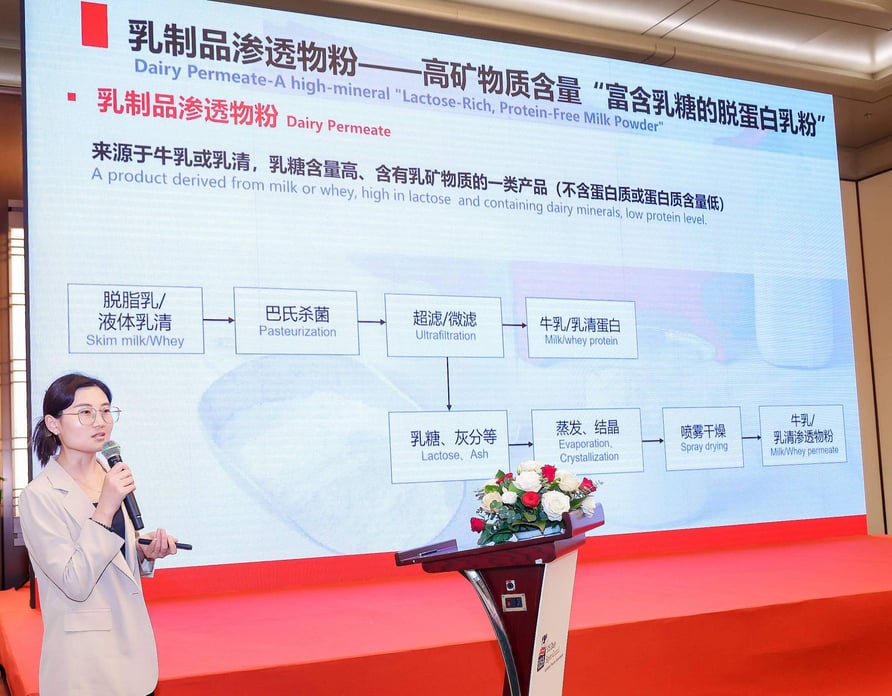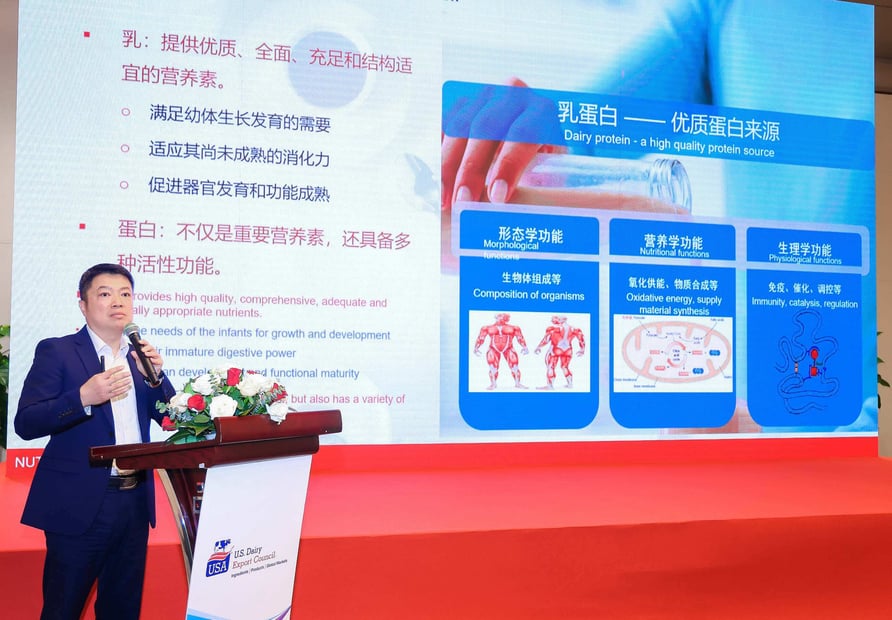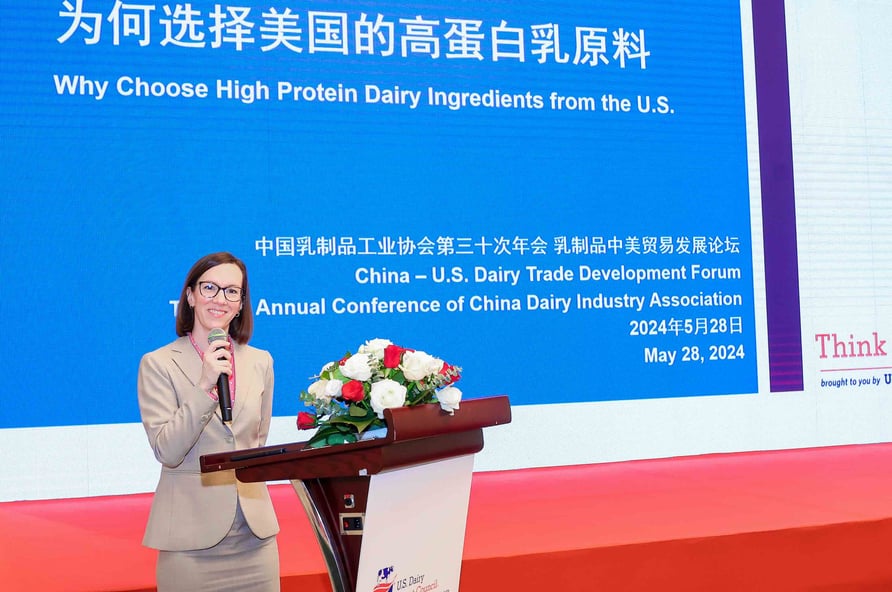HIGHLIGHTS: JUNE 7, 2024
• USDEC presence at CDIA conference in China
• New MOU with Colombia’s Asoleche
• U.S. dairy exports rise in April
• Market Summary: GDT continues to rise
• Latest USDEC International Demand Analysis now available
• More than 140 updates to USDEC Export Guide in May
• Synlait continues to struggle
• FrieslandCampina opens new Malaysia plant
• Company briefs: Müller, Suntado, Lakeland Dairies
Featured
USDEC strengthens U.S. ties to Chinese dairy, food and beverage sectors at 2024 CDIA conference
USDEC reinforced its decade-plus relationship with China Dairy Industry Association (CDIA) and the Chinese dairy sector during this year’s CDIA Annual Conference on May 28-29 in Changsha City, Hunan Province. USDEC has participated in this yearly prestigious event for several years, typically with high-profile speeches delivered by the USDEC CEO at the opening ceremony and an in-depth USDEC-sponsored symposium: the China-U.S. Dairy Trade Development Forum.
This year, at CDIA’s invitation, Vikki Nicholson-West, USDEC’s senior vice president, Global Ingredients Marketing delivered a speech at the opening ceremony to an audience of more than 800, including many current and potential U.S. dairy ingredient buyers, primarily from dairy and infant formula companies. USDEC has continued to engage with over the years.
While highlighting U.S. dairy performance in China, especially on high-value dairy proteins and lactose, Nicholson-West emphasized U.S. dairy’s commitment to be China’s dairy partner and the U.S. dairy industry’s dedication to bringing sustainably produced, safe, high-quality and nutritious dairy products to Chinese consumers.

On the invitation of CDIA, USDEC’s Vikki Nicholson-West delivered a speech at the opening ceremony to the organization’s annual conference.
U.S. capacity for quality dairy
After the opening ceremony, USDEC held the China-U.S. Dairy Trade Development Symposium. The event was well attended, attracting an estimated 130 people.
The symposium highlighted the United States’ growing production capacity, the advantages delivered by U.S. dairy ingredients and USDEC’s innovation endeavor in China with Jiangnan University (JU). That JU partnership focuses on using U.S. dairy protein and permeate ingredients to develop China-friendly formulations.
CDIA Honorary Chairman Kungang Song, a renowned figure in the Chinese dairy industry, introduced the symposium, followed by a lineup of U.S. and Chinese dairy ingredient experts, including:
- Nicholson-West and Annie Bienvenue, USDEC vice president, Global Ingredients Technical Marketing Services. Bienvenue focused on why Chinese dairy, food and beverage manufacturers should choose U.S. high protein dairy ingredients and echoed Nicholson-West’s messaging on USDEC’s efforts on sustainability, innovation and partnership building. Both fostered a better understanding of U.S. dairy’s growing product portfolio, expanding production capacity and desire to do business in China.
- Professor Peng Zhou, Jiangnan University. Professor Zhou highlighted the nutritional value of consuming dairy protein-fortified foods in the context of the Chinese diet and presented examples of foods “upgraded” by adding U.S. dairy protein ingredients. He highlighted a range of product prototypes developed by JU to fit the taste preferences of Chinese consumers, including high-protein ice cream, puree, low glycemic index porridge and noodles.
- JU Associate Professor Lina Zhang. Dr. Zhang reinforced permeate’s application advantages, including reducing salt and sugar, enhancing flavor, delivering dairy minerals and lowering costs. She also shared JU-developed prototypes, including milk tea, sports beverages and a lactobacilli beverage using U.S. dairy permeate, and presented winning formulations from U.S. Dairy Student Innovation Competitions created under the USDEC-JU partnership.
- Will Loux, USDEC senior vice president, Global Economic Affairs. Loux shared the dairy supply and demand outlook, highlighting new U.S. production capacity for cheese and whey ingredients and the United States’ unique position to meet growing global demand.
- Donna Berry, USDEC consultant, and Chang Su, USDEC China representative. Using new product launch data from Innova Market Insights, Chang discussed the latest new product development trends for foods including dairy proteins, while Berry focused on novel products in the yogurt category. Chang also reviewed China’s regulations pertaining to dairy permeate and global application trends.
- Several USDEC members delivered presentations, including representatives from Agropur, Darigold, Glanbia Nutritionals, Milk Specialties Global and Proliant Dairy Ingredients.

An icon of the Chinese dairy industry, CDIA Honorary Chairman Kungang Song Introduces the China-U.S. Dairy Trade Development Symposium.

JU Associate Professor Lina Zhang highlights U.S. dairy permeate’s value in various food and beverage applications.

JU Professor Peng Zhou explored the nutritional value and the university’s product innovation work with U.S. dairy proteins.

USDEC’s Annie Bienvenue highlights the major functional, nutrition and taste benefits of U.S. dairy proteins.

Chang Su, USDEC China representative, discusses new product trends with dairy protein and permeate.
USDEC signs MOU with Colombian dairy group Asoleche
On June 4, USDEC and NMPF signed a memorandum of understanding (MOU) with the Colombian Association of Dairy Industry (Asoleche) to increase cooperation between the U.S. and Colombian dairy industries as they advocate for pro-trade and science-based policies. The deal will focus on improving communications and knowledge sharing between the industries, highlighting the economic and social importance of the dairy industry and eliminating trade barriers that harm producers and consumers.
“This agreement is another significant step in the U.S. dairy industry’s commitment to working with and supporting our partners in Colombia and across Latin America,” said Krysta Harden, president and CEO of USDEC, in a joint USDEC/NMPF press release on the MOU. “Both industries benefit when we have a robust trade relationship. Everyone—especially Colombian consumers—are worse off when policymakers impose ill-advised trade barriers. We look forward to continuing to build on our strong partnership.”
Ana Maria Gómez, director general of Asoleche, emphasized the goal of promoting milk consumption in Colombia. The MOU, she said, the MOU would “provide us with more tools for innovation through the exchange of knowledge between industries. We hope that together we will develop innovative projects that benefit the entire dairy chain and consumers in Colombia who rely on both domestic and imported dairy products.”
The Asoleche MOU is the latest in a series of cooperative agreements USDEC has made with Latin American dairy groups to support dairy-friendly policies in international forums. It complements similar agreements signed over the past few years year with Sociedad Rural Argentina, the Chilean Federacion Nacional de Productores de Leche (Fedeleche) and the Inter-American Institute for Cooperation on Agriculture (IICA).

Nelson Guerrero, chairman of Asoleche; USDEC’s Jaime Castaneda; Ana Maria Gómez, director general of Asoleche; and Rachel Nelson, head of USDA’s Foreign Ag Service Office in Colombia at the signing of the new dairy cooperation MOU.
U.S. dairy exports rise 3% in April; year to date volume down only 1.6% year-to-date
Year-over-year (YOY) U.S. dairy exports rose 3% in April in milk solids equivalent terms (MSE). The increase evened up the monthly scorecard year-to-date, with January and March declining and February and April rising. It also cut the year-to-date U.S. MSE export shortfall to 1.6%.
Another big month for cheese, improving whey volumes, and solid gains in butterfat overcame milk powder and lactose declines in April.
U.S. cheese exports remained on a roll, rising 27% (+9,742 MT) to 46,270 MT in April. Volume was second only to March 2024 in most cheese ever shipped in a single month. Exports to Mexico soared 53% (+5,973 MT) to an all-time record of 17,249 MT. But growth was much more diversified, with YOY volume up across geographies: Southeast Asia +102%, South Korea +69%, the Middle East/North Africa (MENA) +40%, the Caribbean +24%, and Japan +11%.
U.S. high-protein whey sales (WPC80+) also continued their torrid growth pace, increasing 26% (+1,459 MT). YOY exports to China nearly tripled to 2,181 MT while volume to Brazil surged 66% (+338 MT). Low-protein whey failed to match the lofty gains of its higher-value cousin but posted its biggest increase of the year: +8%, +3,345 MT. Mexico (+79%, +2,120 MT) led the gain, but China, notably, posted its first increase of the year (+5%, +916 MT) as its pork sector began showing signs of recovery.
U.S. butterfat (butter and AMF) shipments also rose, marking their first monthly YOY increase since November 2022. Butter exports jumped 23% (+481 MT) and AMF volume more than doubled (+399 MT). MENA led the total butterfat increase in April (+323 MT) with support from Canada (+199 MT).
YOY nonfat dry milk/skim milk powder (NFDM/SMP) fell 2%, as declines to China (-1,794 MT) and Vietnam (-3,009 MT) erased strong sales to South America (+2,105 MT) and the Caribbean (+1,116 MT). While U.S. shipments to Mexico fell 1% (-599 MT), it was the best U.S. performance of the year at 33,127 MT and the second highest April volume ever.
For more on the April results, including deeper dives into Mexico and China and what might be coming in the months ahead, read the U.S. Dairy Exporter Blog story, “April Dairy Exports Rise 3%.” In addition, visit the USDEC Data Hub and experiment with the interactive charts.
Market Summary
GDT continues to rise
The Global Dairy Trade (GDT) Price Index rose a modest 1.7% at the June 4 auction, as tight supply continued to bolster prices—a situation that could hold sway through the Southern Hemisphere winter. Offer volumes were the lowest of the year.
While demand was sufficient to lift auction prices, it remains subdued overall, particularly in North Asia (China), which faded slightly after showing initial signs of a potentially stronger market return at the May 21 auction.
Southeast Asia led all WMP buyers (although volume was down from May 21 and from the same auction the previous year). Europe was the top SMP buyer, and the Middle East took home the No. 1 position in AMF and cheddar. It was only in butter where North Asia (China) came out on top.
The average winning WMP price rose 1.7% to US$3,478/MT. Butter gained 1.7% to US$6,864/MT. AMF rose 0.9% to US$7,417/MT and has established new record highs in the past three auctions. The price gains for all three products, however, were tilted toward the nearer term contracts, which have bigger supply question marks given New Zealand’s off season and a muted Northern Hemisphere spring flush.
The average winning SMP price grew 3% to US$2,722/MT and showed more consistent gains across all contracts. The EU led all buyers and increased purchasing versus the previous auction and same auction the previous year. North Asia (China) and Africa also boosted buying compared to the previous auction but not against previous year.
Cheddar inched up 0.2% to US$4,248/MT, keeping prices largely steady for the past two auctions.
Download USDEC’s latest International Demand Analysis
After growing in four out of the last five months, global dairy trade slipped 3% in March in milk solids equivalent (MSE) terms, according to USDEC’s latest International Demand Analysis. As in February, the Middle East/North Africa and Southeast Asian purchasing was strong, rising 15% and 11%, respectively. But unlike February, China and Mexico dipped back into negative year-over-year territory, and South America posted its first year-over-year (YOY) decline since last September—and a sizable one at that (-18%).
Disappointing Northern Hemisphere milk production has limited exports out of the U.S. and EU, and economic challenges continue to undermine consumer demand in many markets.
Of the big-three suppliers (the U.S., the EU and New Zealand), the Kiwis were the only to post a YOY increase in exports in March (+10.1% MSE). U.S. and EU exports fell 7.6% and 9.8%, respectively. For more on March results, including why New Zealand might be hard pressed to maintain its March growth pace, download the International Demand Analysis.
The monthly reports is packed with charts, graphs and commentary, providing members with a forward-looking glimpse at world markets from a U.S. exporter’s point of view. The report analyzes demand in the key markets for cheese, NFDM/SMP, whey (HS Code 0404.10) and WPC80+, and also includes shorter summaries for lactose, butterfat and WMP. For questions and comments, please reach out to William Loux (wloux@usdec.org) or Stephen Cain (scain@nmpf.org).
Market Access and Regulatory Affairs
USDEC makes 143 Export Guide document updates in April
The MARA team updated or revised 143 documents in the USDEC Export Guide last month. Here are some highlights:
Volume 1: Tariffs and Classification
- Brazil: Several temporary MFN rates expired and as a result, tariff rates increased. Impacted products include lactose, infant formula, milk drinks, milk proteins, and several processed food categories.
- Egypt: A new temporary tariff exemption is extended to July 11 for milk powder, certain milk fats, and fresh cheese.
- Israel: Changed several cheese tariff rates.
Volume 2: Import Requirements
- AMS Sanitary Certificate: AMS transitioned both the Colombia and Turkey sanitary certificates from eDocs to ATLAS.
- European Union: EU health certificate section now includes a link to the AMS Dairy Grading Program’s EU FAQ guidance document and a link to the updated EU certificate template.
- Malaysia: The U.S. Dairy Plant Registration or Approval section notes updated documentation required for facility approval.
Volume 3: Labeling and Product Standards
- Egypt: Revised standards for milk powder and cream powder, skimmed milk with vegetable fat in powdered form, evaporated milk, and sweetened condensed milk.
- Mexico: Added a standard for Packaging under “other regulations.”
- Singapore: Updated contaminants section in each compositional standard.
Every month, USDEC’s Market Access team emails a list of guide updates to interested members. If there is anyone at your company who should be included on the distribution list for that email in the future, please contact Jessica Smith at jsmith@usdec.org.
Company News
Synlait Milk’s business struggles continue
New Zealand dairy producer Synlait Milk continues to face difficulties as it works to overcome high costs, declining sales and unpaid debt. More than half of its 300 suppliers have reportedly notified the company that they intend to stop supplying milk after their current contracts expire. A company statement downplayed the potential exodus, saying the notices signal that the farmers “want to see Synlait’s balance sheet deleveraged, so advanced rates can be lifted further, and submitting a cessation notice provides an option, rather than a clear intention to sign with other processors.”
To reduce its debt, the company is working to sell its manufacturing plants in Auckland and Pōkeno, and is also looking to sell its consumer Dairyworks business, which owns brands such as Rolling Meadow. Synlait also agreed to the terms of a NZ$130 million (about US$80) loan with its major shareholder, China’s Bright Dairy (subject to a pending shareholder vote). The company expects to draw down the full amount of the loan to meet its prepayment obligation to the company's senior lenders, which is due on July 15. (Company reports; The Post, 6/3/24; Radio New Zealand, 6/3/24)
FrieslandCampina Malaysia dairy plant opens
Dutch Lady Milk Industries Berhad (DLMI), a subsidiary of Netherlands-based Royal FrieslandCampina (RFC), opened a new dairy plant in Malaysia that the company says will be able to double its production capacity to meet the growing demand for high-quality and nutritious dairy products in the region. Previous statements from DLMI said the new production facility “will revolutionize our supply chain processes to enable us to produce DLMI’s range of nutritional products, with the added scalable capacity to manufacture other innovative variations in the future driven by consumer trends and occasions.” The company said the plant is also designed to achieve a 30% reduction in energy and water consumption by 2030, compared to its 2022 baseline. (Company reports, Dairy Industries, 4/20/21)
Suntado opens Idaho dairy processing plant
Idaho-based Suntado opened a 190,000 sq.-ft. production facility in its headquarters city of Burley (see Global Dairy eBrief, 3/24/23). The new plant can handle more than 450 MT of raw milk per day, processing it into shelf-stable and ESL milk as well as other fluid dairy products. The site opening comprises phase one of a three-phase project the company projects will triple future capacity. (Food Engineering, 5/30/24)
UK’s Müller looks grow milk powder export business
Müller UK & Ireland, the British division of German dairy manufacturer Unternehmensgruppe Theo Müller, is acquiring West Lancashire-based Yew Tree Dairy, a maker of milk powder, fresh milk and cream. Muller plans to use Yew Tree’s powder capabilities (Yew Tree operates a drying facility in Skelmersdale, West Lancashire) to become “a major producer and exporter of powdered milk products.”
“This acquisition will enable us to tap into global dairy consumption growth, unlock additional export opportunities and continue to drive supply chain resilience,” said Rob Hutchison, CEO at Müller Milk & Ingredients. (Company reports)
Company briefs
Ireland’s Lakeland Dairies is asking £9.5-11 million (US$12-14 million) for its site in Banbridge, Co. Down, Northern Ireland. The co-op shuttered the butter manufacturing and powder storage facility (and two other sites) earlier this year as part of a restructuring plan announced last fall. Sweden-based dairy alternative company Oatly confirmed it has scrapped plans for its first UK plant-based beverage facility. The company said it is “identifying new ways to serve the UK market [by] utilizing existing facilities across Europe.” … California-based dairy processor Clover Sonoma named John Coletta as its new CEO effective July 1. Coletta, who has 35 years of food industry experience, succeeds retiring CEO Ken Gott. (Company reports; BBC, 5/30/24; Agriland, 5/30/24)
In Case You Missed It...
U.S. Dairy Exporter Blog
Market analysis, research and news subscribe hereUSDEC Twitter feed
Follow us here.